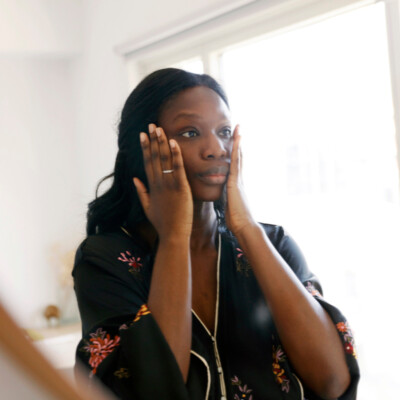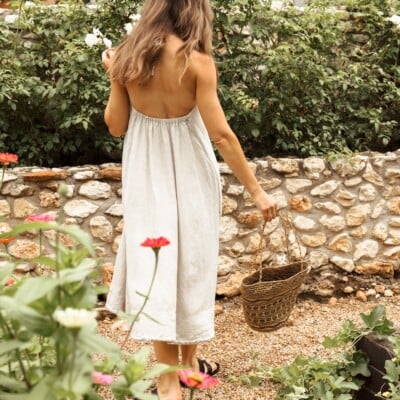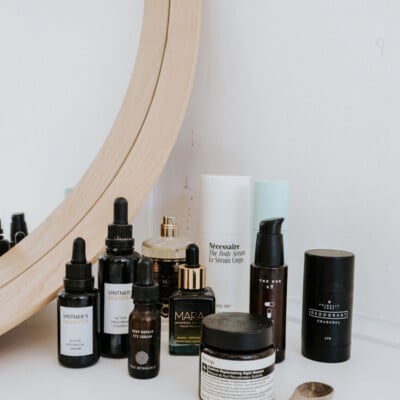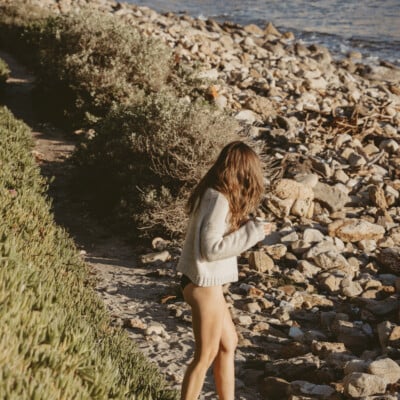So excited to welcome my favorite vintage shopping expert on the planet, Beth Styles (and no, the last name is not coincidence — Beth is married to my big brother!) Beth is the owner and curator of Parsimonia Vintage in St. Louis. I’ve always admired the way she uses fashion as an expression of creativity, and more than anyone else I know, she has that magical knack for finding vintage pieces that speak to her unique style — as well as that of her loyal clientele. For me, one of the biggest challenges of shopping vintage has always been finding the right fit — it seems like pieces from previous decades are sized all over the map! I asked Beth to share her secrets for finding vintage treasures that fit perfectly, flatter your body type, and bring the fun back into shopping! Click through the slides for her can’t-miss tips.
Photography: Sandy Gutierrez Photography
Hair/Makeup: Megan Gad, Karson Kelley, Morgan Dwiggins
Models: Domineque Nicole (hourglass), Danielle Bonczewski (straight), Amanda Danielle (inverted pyramid), Tiffany Reese (pear)
Styling: Beth Styles

The myths
In the time my little vintage boutique has been up and running, I’ve heard it all: “Vintage clothes are too small.” “Vintage clothes are too big.” “I’m not busty enough.” “I’m too busty.” “I’m too short.” “I have too many curves.” And, you know, I get it. If vintage isn’t something you’ve ever had in your wardrobe, it can be tricky to walk into a store and know where to start, especially when it comes to fit.
Back in the day, having clothes tailored (or making them yourself) was much more common than it is now. As such, many vintage pieces are heavily customized to a specific set of body measurements. Sizes and silhouettes have also changed over the past half-century (and beyond), so looking at a number on an old label is an often- inaccurate way to judge whether or not a garment will hug (or drape) you in all the right places.
For both of these reasons, my first suggestion to customers is always to try it on. That’s hands down the best way to know if it will fit. However, there are steps you can take to streamline the picking process — and increase the odds of bringing winners into the dressing room.

Know your measurements
There are three measurements every woman should know when shopping for vintage: bust, waist and hips. Armed with these numbers, you can theoretically walk into any vintage store and be able to find something that either fits, or only needs minor tailoring to make it perfect (an expectation you should absolutely have when delving into the world of vintage). Some stores (like mine), write these measurements on the tags, but for those that don’t, you have two options: Bring the piece to the counter and have the staff person measure it, or keep tailor’s tape in your purse (available any place that sells fabric) and measure it yourself before hauling it into the fitting room. ModCloth has a helpful guide that shows how to do lay-flat measurements. Just remember to double the number so you can compare them to your own, which we’ll talk about now!

Busted
To get accurate measurements, there are two things you must do: Start in your skivvies and always keep the tailor’s tape parallel to the floor. To measure your bust, take the beginning of the tape in one hand and, with your other hand, grab the tape and bring it around your back at chest level. Bring the two ends together at the fullest part of your chest. The number at which the two ends meet is your bust size.

Middle Ground
When it comes to the waist, we’re looking for your natural waistline, not where your low- rise jeans stop. While looking in a mirror, lean to one side to see where the crease forms. Bring the tailor’s tape around this point on both sides of your body. The number at which the two ends meet comfortably (don’t pull it too tight) is your waist size.

Get hip
Whether or not you’re all about your bass, it is a vital part of your hip measurement. Standing with your feet together, bring the tape around the fullest part of your bum and around to the front. Like your waist, the number at which the two ends comfortably meet is your hip size.
Now that these numbers are in your arsenal, some of you might feel that’s all you need to tackle a trip to your local vintage shop. But for those needing an extra level of advice, let’s take what we’ve learned one step further.

Know your body type
The ratio of your measurements will likely put you into one of four basic body types: hourglass, straight, inverted pyramid or pear. There are several sub-types in between, but to keep things simple we’ll stick with these. Why is this important? Because each decade of popular vintage fashion lends itself to certain body types, and armed with that knowledge — as well as your exact measurements — you’ve given yourself two starting points to help make your shopping trip a success!

Hourglass
Ladies with a well-balanced bust and hip ratio who also have a small waist fall into the “hourglass” category. The key to dressing this body type is accentuating your curves, which can done a couple ways. A belted dress with a full circle skirt is perhaps the most
well-known option (it can also be done with a circle skirt and blouse tucked it). You could also go a more fitted route and make use of the wiggle dress or high-waisted pencil skirt. Both routes provide some great options.

Straight
If your three basic measurements hover around the same number, odds are you belong in the “straight” group, which lends itself to a couple decades. The first, but a little more difficult and expensive to find, is the 1920s (think “Downton Abbey” and “Great Gatsby”). The boyish shape of loose-fitting dresses, drop waists and long cardigans all lend itself to this body type. You could also go with the more fitted look of the mod ’60s dress (think iconic Twiggy) to show of your legs; boxy tops that accentuate your shoulders; or fitted, straight-cut two pieces with a belt to help give the illusion of a waist.

Inverted triangle
Those with a proportionally larger upper body that tapers down to a narrow lower body have an “inverted triangle” fit, which looks great in the bias cuts of the 1930s, the strong-shoulder silhouette of the 1940s and 1980s, and the circle skirts of the ’50s if you’re looking to balance out your bust. As with the straight cuts, oftentimes inverted triangles have great legs, so the shorter hemline of the mod ’60s (or the mini-skirts and dresses of the ’90s) works for you, too, especially when paired with knee-high boots!

Pear shape
Last but not least are my pear-shaped ladies (of which I am a proud member). Similar to our hourglass sisters, we have rounded bottoms and a defined waist, but our bust is smaller than our hips. As such, we lend ourselves to the A-line cuts of the 60s dresses, which oftentimes have higher necklines that give the illusion of a balanced bust-to-hip ratio. The empire cuts of the ’70s also serve us well, with the higher waistlines hitting our own natural ones and flowing out over the hips.
These are all, of course, general guidelines, but hopefully they help bring some vintage into your modern wardrobe! Happy hunting!
Thanks for stopping by, Beth! And if you guys are ever in the St. Louis area, don’t miss a trip to her amazing vintage store.
contributors: Sandy Gutierrez Photography; (hair/makeup) Megan Gad, Karson Kelley, Morgan Dwiggins; styling: Beth Styles




